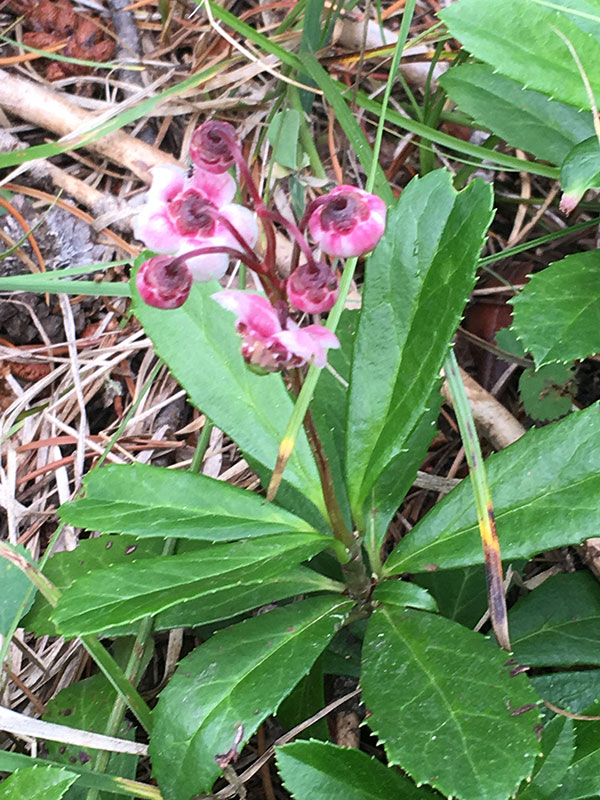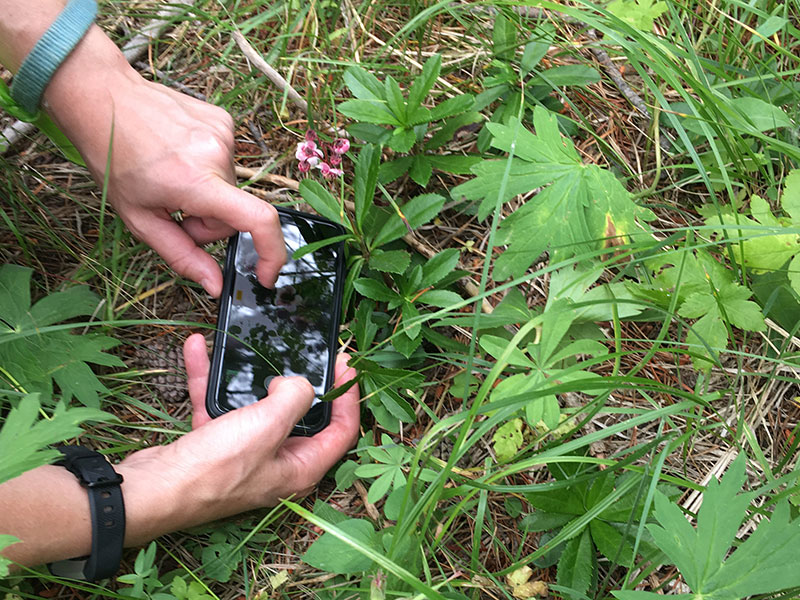Chimaphila umbellata / pipsissewa
- small herb/forb
- shiny, toothed lance point leaves
- half-inch, pink and white, upside down flowers
- flowers in umbel like cluster
- flowers with minimally visible style
Also known as: umbellate wintergreen, prince’s pine
See also: Pyrola asarifolia / pink pyrola
Pipsissewa is a small but woody perennial – or a rhizomatous herb. The two forms are sort of gradations of the same life style. It is found on well-drained soils in mixed or coniferous woods, usually in light shade. It can also be found in dry, sandy forests, or on forest edges, or even on roadsides. Because of its rhizome system it is often found in small patches. Pipsissewa is evergreen, the leaves persisting through the winter, albeit buried in snow. As such it is one of the “wintergreens” (but not the one in chewing gum). On the other hand, the leaves can be used as a flavoring in candy and soft drinks; the flavor is like root beer. The plants are short, perhaps a foot tall with the inflorescence.
Unless you are looking for this plant, you might only notice it when it is in bloom. The flowers are pink and white, and pendant (i.e. upside down). They are produced in a small umbel of 4 to 8 together. They are small, on the order of 1/2-inch across. If you have been fortunate enough to have previously seen the pink pyrola, then you might at first mistake this for that. At the flower level, there are two clear differences. First, the style of pipsissewa is not really visible; in the pink pyrola, it stands out like an elephant’s trunk. You have to lie on the ground to see either. Second, the arrangement of the pipsissewa flowers in a multi-branched cluster – the umbel – is different from the more linear raceme arrangement of the pyrola. The fruits are similar… globose capsules which often hang on through the winter (again, under a couple feet of snow).
The leaves of the two species are also distinguishing. Pipsissewa has shiny, bright green, leathery, toothed leaves rather than oval ones. They are arranged oppositely in pairs or circularly in whorls of 3–4 along the stem, not as a rosette at the base. The leaves are longer than wide, somewhat like an inverted lance point, and have toothed (serrate) margins. Look closely and the teeth have fine hairs at the ends.
Perhaps the most interesting biological feature of this species is that it is not fully autotrophic despite the intense green-ness of the leaves and their persistence all year. Rather, they are mixotrophic, specifically myco-heterotrophs. That means, they get a significant portion of their nutrition, including carbohydrates, from soil fungi, i.e pipsissewa is a parasite on the fungi. Since fungi don’t do photosynthesis, it is actually a parasite on whatever tree (usually) the fungi are aiding as mycorrhizae. So pipsissewa is a “mycorrhizal cheater”.
One final point. I was at first very confused by seeing pyrola type flowers with shiny long leaves. It turns out that although pyrola and pipsissewa are now both in the Ericaceae, they once were in their own family, the Pyrolaceae. They have also been, at one point, treated as a tribe, the Pyroleae, which was a subfamily of the Monotropoideae. Regardless of what they are a subfamily of, there are four associated genera: Chimaphila contains 5 species, Pyrola contains 30 species and Moneses and Orthilia which are monotypic (one species). There are a number of fully parasitic species in the group as well as other mixotrophs. It is the floral structures, and to a lesser extent the leaves, that result in the separation of Pyrola and Chimaphila.
| Color | |
|---|---|
| Family | |
| Blossom size | |
| Inflorescence size | |
| Inflorescence type | |
| When? | |
| Where? |

